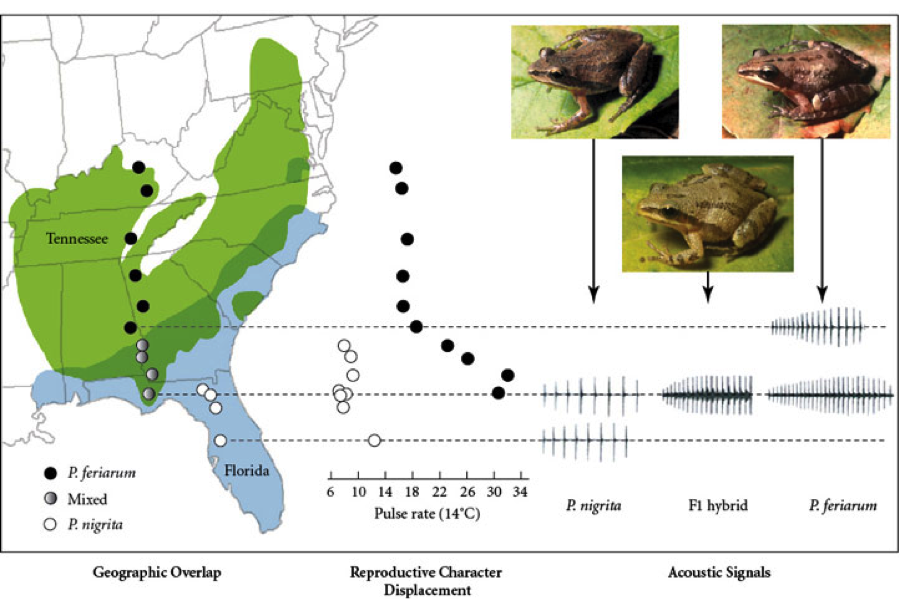Closely related animal species are often so similar that it is
hard to distinguish them. This immediately leads to the question of how the individuals
of such species, when in sympatry, can recognize their conspecifics. Usually, the
species differ in traits (i.e., species recognition signals; e.g., visual and
sound signals) that are detectable by sensory mechanisms. Less is known,
however, about how these phenotypic differences evolve. A common view is that
hybrids suffer reduced fitness or cannot be produced whatsoever, and therefore selection
should favor individuals with traits that avoid interspecific matings. By
diverging in such traits, females and males of closely related species are less
likely to waste energy in failed matings. This widely accepted assumption is
usually referred to as “reproductive character displacement” (Losos, 2013).
 |
| From Evolution (Third edition; Futuyma, 2013). |
When
Brown and Wilson (1956) described character displacement, they proposed the
following process: populations of two closely related species, after first
coming into contact with each other, interact
“in such a way as to diverge further from one another where they occur
together”. Such divergence minimizes the chances of both competition and
hybridization between the species, and therefore favors coexistence over
exclusion.
While
it is generally accepted that natural selection is the force increasing the
frequency of the divergent traits, whether or not the resulting divergence is
driven by the interaction between
the two species (e.g., competition) remains uncertain. If a pattern of differences
is consistently detected between populations of two closely related species
when they are compared in allopatry versus sympatry, it seems reasonable to
attribute this pattern to the interaction of both species. However, a number of
processes other than a response to interspecific interaction may result in a
“displacement-like” pattern—substantial
differences of the environments between allopatry and sympatry, phenotypic
plasticity or even random processes can all trigger differentiation (Kamath,
2014).
Based on six criteria (Box 1) established by Schluter &
McPhail (1992) as general indicators to rule out alternative processes that
might lead to a displacement-like pattern, recently Stuart & Losos (2013)
pointed out that only a small portion (9 of 144 cases) of recent studies
claiming evidence for ecological character displacement can conclude with a
high degree of certainty that the interspecific interaction led to the observed
divergence. According to Stuart & Losos, falsification of only one of these
six criteria is enough evidence to determine that such divergence did not
result from character displacement. Consequently, their findings suggest that most
documented cases of ecological character displacement are equally consistent
with other evolutionary and ecological phenomena. Although these two studies
focus only on ecological character displacement, it is worth noting that the
same eco-evolutionary principles underlie reproductive character displacement, so
that alternative processes could also explain phenotypic differentiation
presumably derived from interspecific interaction.
Despite the concept of character displacement having remained in
the evolutionary literature for decades, this assumption has seldom been
subjected to critical scrutiny. Indeed, it was not until recently that
significant progress in designing thorough studies to rigorously test this adaptive
hypothesis was achieved (e.g., Stuart et al. [2014]).
Box 1: Modified from
Stuart and Losos (2013). The six criteria for Ecological Character Displacement
(ECD).
References
Brown
Jr., W. L. and E. O. Wilson. 1956. Character displacement. Systematic Zoology
5(2): 49–64.
Kamath, A. 2014. http://www.anoleannals.org/2014/10/25/rapid-evolution-in-anolis-carolinensis-following-the-invasion-of-anolis-sagrei/
Losos, J. 2013. http://www.anoleannals.org/2013/08/12/reproductive-character-displacement-and-dewlap-color-in-haitian-anoles/
Schluter,
D. and J. D. McPhail. 1992. Ecological character displacement and speciation in
sticklebacks. The American Naturalist 140: 85–108.
Stuart Y. E. and J. B. Losos. 2013. Ecological character
displacement: glass half full or half empty. Trends in Ecology and Evolution
28(7): 402–408.
Stuart
Y. E., Campbell T. S., Hohenlohe, P. A., Reynolds, R. G., Revell, L. J. and J.
B. Losos. 2014. Rapid evolution of a native species following invasion by a
congener. Science 346: 463–466.
A blog post reviewing Stuart
and Losos (2013) from a different perspective:



